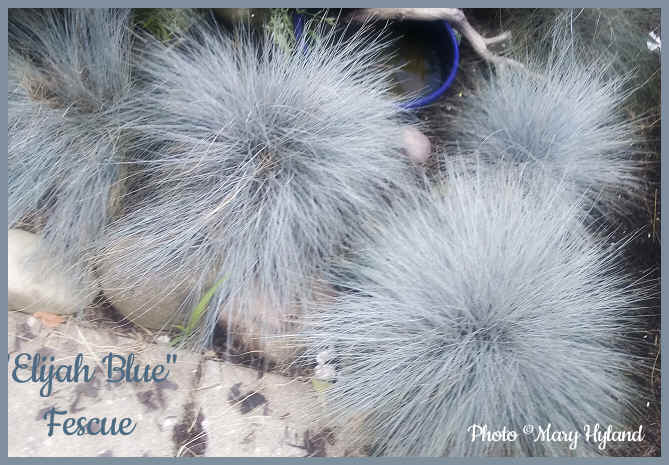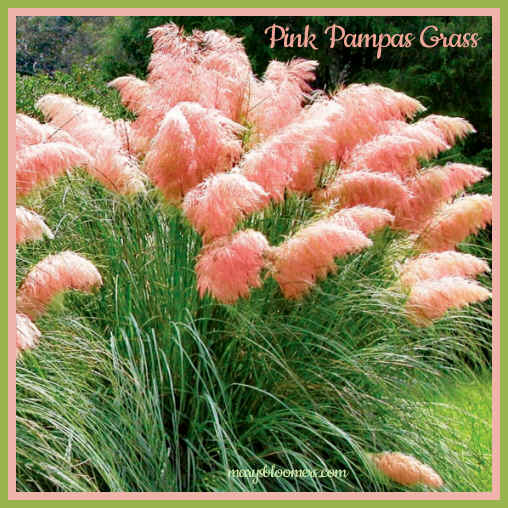The majority of commonly-grown
ornamental
grasses are deciduous. Their foliage dies and turns brown in the
fall, but often remains standing.
There are a few evergreen types available that look great all year long.
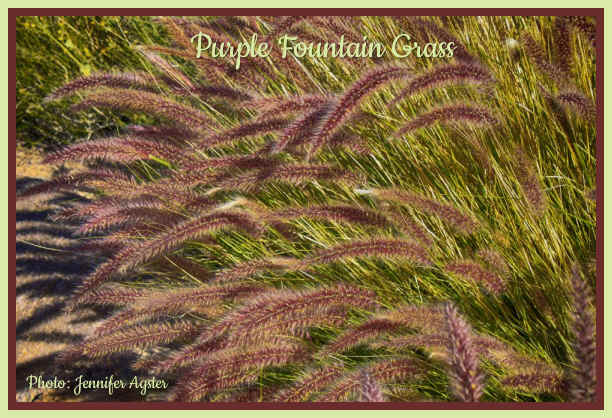 |
Fountain grass (Pennisetum) is a
mound-forming ornamental grass and a garden favorite, and growing fountain grass is easy.
They can also grow in containers, indoors
and in the garden. The cascading leaves on this plant have a fountain-like
appearance. Fountain grasses are
available in several sizes.
Purple
fountain grass is used as an annual, and must be brought indoors
in northern zones. It's very pretty in containers or
in beds. Deer resistant and hardy only in
Zones 9 to 11. Give plants full sun and well-drained soil
|
Most ornamental grasses prefer
full sun locations, there are a number of grasses that
will provide interest to shaded areas in the garden. Many are
beautiful in containers, but bear in mind that container plants are not
as hardy as when the grass is planted in-ground. Meaning.... if i grow a grass hardy
to Zone 6 in a pot outdoors, it's hardiness is diminished by at
least a zone or two. Meaning it became hardy only to zone 8, while in a
container. Those are
the plants that i have to bring indoors. And they grow great indoors, as
well as outdoors.
Do consider the weight of the plants in
containers if you have to bring them inside.There are several cold hardy
ornamental grasses that will be able to handle the winters outside, but
mainly those that you don't grow in pots. Dwarf perennials grown in the
garden beds are the way to go.
Indoors - Except for the
water-loving
varieties, most ornamental grasses won't need extra water
once they've become established. Water every other day after
planting, gradually extending the time between watering. After 2
or 3 weeks, watering twice a week should be plenty. |
|
Short and Medium Garden Varieties
Blue Oat Grass - Deer tend to leave this plant alone. This ornamental
grass attains a height of 2 to 3 feet tall, with a similar spread. It
tolerates some shade, but grow it in full sun (and well-drained soil) to
enjoy the signature blue hue of its foliage. The plant produces spiky,
dark flowers with a bluish tint in summer that turn harvest gold in
autumn. Steel-blue foliage
Zones: 4 to 8
Sun Exposure: Full sun
Northern sea oats- grows 2 to 3 feet high in loose clumps of
green foliage. Its name comes from its seed pods, which look like oats.
This deer-resistant ornamental grass is cold-hardy to zone 5.
**My Top Pick for decorative grass
to use everywhere - Elijah Blue Fescue.
Zero Maintenance.
Mature
plants are about 1 foot by 1 foot. Grown in zones 4 to 8 (Festuca
glauca ). Very pretty and ornamental blue-green grass i use
everywhere. It's beautiful for 4 seasons.
Mounding, neat and dense evergreen, clumping, drought-and pest-free. The
plant looks like a spiky puffball. Gorgeous as edgings along
pathways, perfect between plants and for edging a flower or
vegetable bed. It takes both sun and shade. It works very well in
my Asian and Zen Gardens, and needs zero care. Delicate wheat-like
spikes spring from the dense centers in summer. These evergreen
puffballs look stunning when dusted with snow. These also make great
fillers in container gardens and can be used indoors, as well.
Shallow-rooted and easy to re-locate.
 |
Best Varieties For Pots
Choose dwarf and short varieties of
grass, unless you're using them as backdrops or focal
points. Most tall varieties are not happy in containers, and have been
known to just burst out of their pots.
Unlike most potted plants, ornamental grasses do not really thrive
when planted in a general-purpose potting mix. Ornamental grasses do
best when planted in a mixture of compost, topsoil and a small amount of
grit (fine gravel or perlite).
The primary purpose of the ornamental grass is to be pretty. Ornamental
grass isn't meant to be mowed, isn't meant to be uniform, and isn't
meant to be walked on. Lawns, or functional grass, is
mainly negative space. Ornamental grass is used in landscape design in the
same way you would use flowers, shrubs, and trees.
"Burgundy
Bunny" Dwarf Fountain Grass. Red foliage and green blades. Summer
bottlebrush blooms are cream and abundant. The compact size mkes it a
natural for container gardens and small beds. Zones 6-10, and appear
just before the entire plant turns scarlet red in autumn.
|
Blue oat grass - The plants grow 2 to 3 feet tall, with thin spiky
leaves and a clumping growth habit. It is non-spreading, which makes it
an excellent little accent plant in rock gardens and small beds. Similar
to the dwarf fescue,"Elijah Blue". Taller, and not as
round and dense.
Zones: 4 to 8
Steel-blue foliage
Full sun
Soil Needs: Dry to medium-moisture, well-drained
soil
Hakone
grass - It grows 12 to 18 inches tall with a graceful, arching growth
habit.
USDA Zone: 5 to 9
Yellow-green foliage
Part shade
Moist, well-drained soil
Sedge Grass - When grown in containers, their bronze tinged leaves
glow in the sun, while the narrow blades pick up the slightest breeze.
Leatherleaf sedge grows 1 to 2 feet tall, with fine-textured, upright
foliage.
USDA Zone: 6 to 9
Bronze to brown foliage
Full sun to part shade
Rich, moist, well-drained soil
Feed the container plants with a high nitrogen fertilizer a couple of times
during the summer, and cut them back each early spring and
late winter. Other than that, the major maintenance is dividing them
when they outgrow their containers, which can happen quite quickly.
Tidying Up
Grasses In The Garden
Winter
interest is one of the biggest reasons for growing ornamental grass, and
you will miss that if you trim in fall. When spring does come, you cut the
plant back early enough to get the old growth out of the way before new
growth begins so that you cut the new shoots, since they'll be in your way
as you remove dead stalks. Fall is fine, but birds and other habitat
creatures appreciate the old growth.
I
have found that the easiest and neatest thing to do when trimming it back
is to do what hair professional do. I gather a handful at a time and cut
it, trash the trimmings, and then i move onto the next handful. A
handful at a time is way better than chasing and picking up those fine
grass clippings from the ground, after the wind has had it's way with
them.
|
Perennial
Ornamental Grass
In The Garden
- Backdrops, Focal Points and Decorative
Landscape Edgings
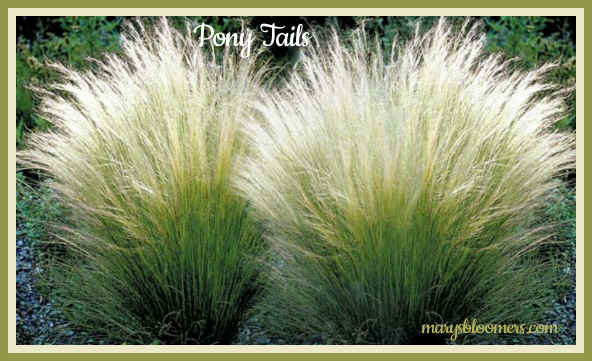
Pony Tails
(Nasella) - Long wispy plumes, narrow and hair-like, 14-18" long.
40 inches tall. Stems become silvery-gold by about August.
Tender perennial zone 7-10.
|
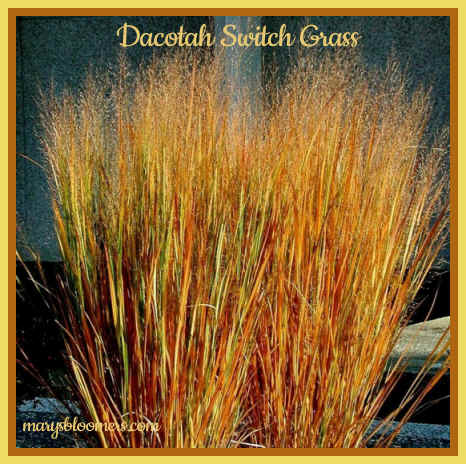
Dacotah Switch Grass - 3-5
ft tall. Reddish stems, golden brown seed heads. Hardy to most of the U.S.
|
|
Pampas Grass - Big,
puffy plumes. Height: 5-7 feet
,
Spread: 3-6Ft.
Full
sun, partial shade. Blooms in
mid summer-fall. Flower plums 1-3' long. Fast
grower. Blooms mid to late
summer. Does best with full sun. The foliage is sharp and may cut your
skin. Use gloves and protective clothing when cleaning up and caring for
this grass. |
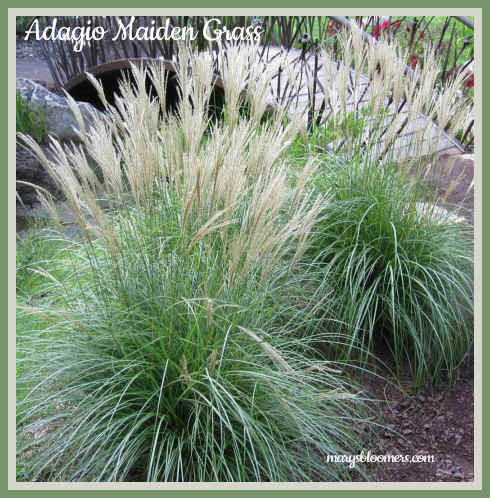
Maiden Grass has an arching, clumping habit. Plumes of
white flowers above the foliage, beginning late summer and
lasting into fall. Fast-growing perennial. Approximately 4 ft.
tall and wide. Full sun. Zone
5/down to -10 degrees F. |
|
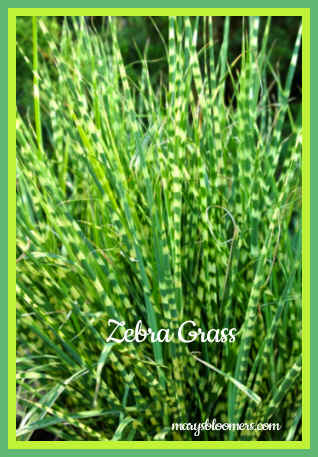
Zebra grass (Miscanthus
sinensis ‘Zebrinus’)
is native to Japan, but will grow in zone 4 to 9. Can get up to 7
feet tall.
Full sun to partial
shade. Highly-tolerant of urban pollution and will thrive in cities.
Its grassy leaves are bluish-green, with yellow
variegation.
|
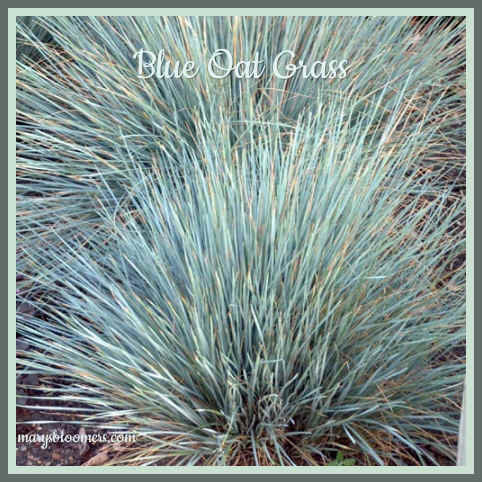
Similar to the dwarf
fescue,"Elijah Blue". Taller, and not as round and dense.
Zones 4-8 |
|
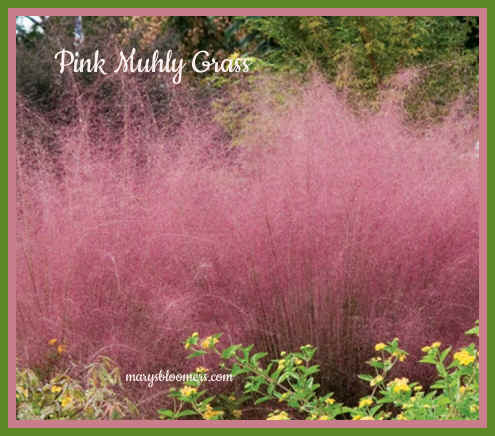
A beautiful solo native specimen plant for patios, or as a focal point in perennial flower
beds. Great accent plant for those who have smaller gardens and not a lot
of room for several large grasses. 3-5 ft. tall. Blooms late summer/fall.
Beautiful as a row in the back of the garden, along a sunny foundation, or
as an edging.
Zones 6-10
|
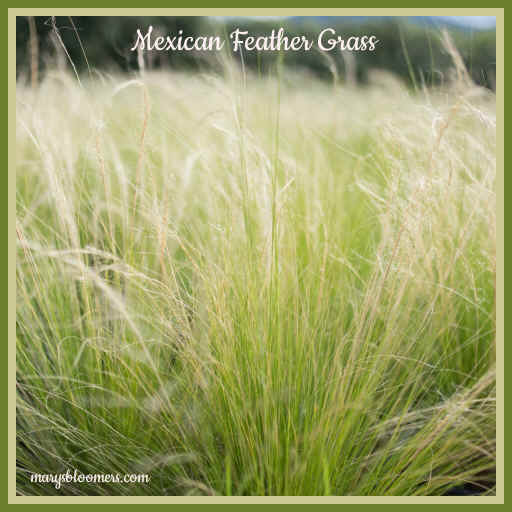
Very pretty and tough Mexican
Feather Grass can be tucked just about anywhere. Full sun. 1-3 ft. tall,
and about 1-2 ft. wide. Great for beds, borders, erosion control, Ground
Cover, Meadow Gardens, and Rock Gardens. Zones 6-10 |
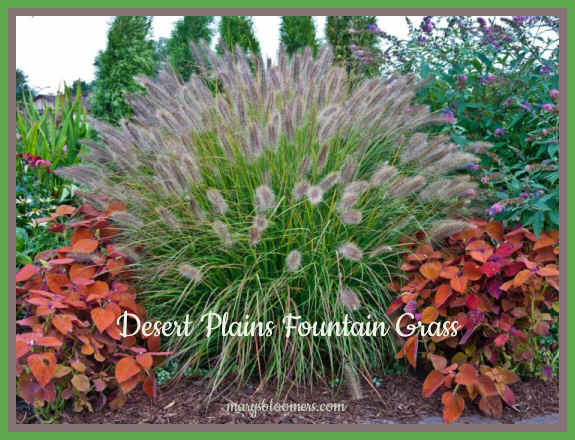
Zones 5-9
Desert Plains fountain grass (Pennisetum alopecuroides) forms
an upright vase-shaped clumpThe narrow leaves are green until midsummer,
when they begin turning a deep red. By fall, the leaves turn shades of
orange and gold. 5-inch bottlebrush seed heads appear in early fall. |
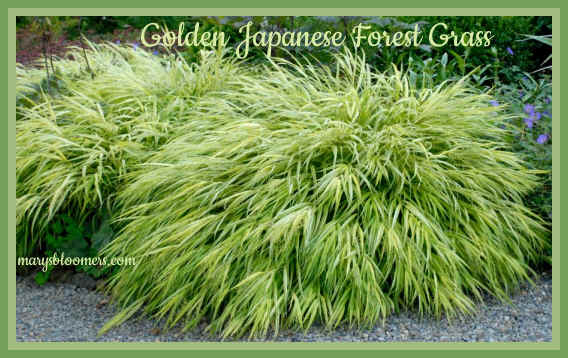
This grass looks very much like a
weeping bamboo. Very beautiful when grown in footed urn pots or
elevatedcontainers, where it shows off its weeping habit freely.
Zones 5-9. Weeping mounds of
gold-striped leaves. Leaf color varies according to the level of light.
In full shade, leaves display lime green stripes. In part shade, the
gold and green variegation is evident. Plants are deer resistant.
|
|
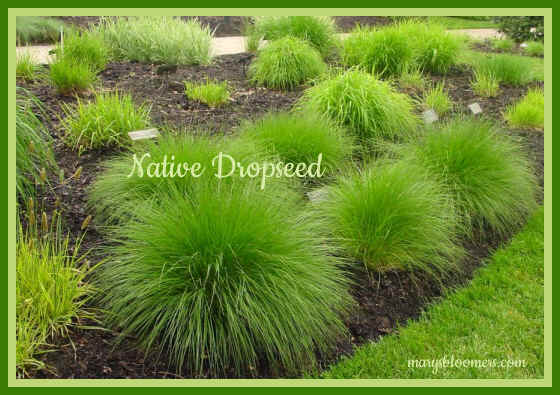
Native prairie grass
that forms rounded clumps. A fine-textured grass, for edging beds, in rock
gardens, xeriscapes. or planted
between other perennials. Full sun, with well-drained, dry, rocky soil.
Insufficient sunlight causes plants to flop open. In wildlife
gardens, it provides cover for foraging birds, the dry stems provide
nesting material, and it produces abundant seeds. Plants are hardy in
Zones 3 to 7, and are heat and drought tolerant. |
Click the pic below to download a free garden design
plan for designing with ornamental
grasses
Multiply the design for larger
areas, and feel free to swap out the suggestions with those of your choice that grow in the same zone.
Plan is in .pdf format, and includes a large
illustration,
a plant list, and detailed planting guide.
|
|



